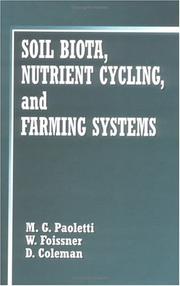| Listing 1 - 8 of 8 |
Sort by
|
Article
Abstract | Keywords | Export | Availability | Bookmark
 Loading...
Loading...Choose an application
- Reference Manager
- EndNote
- RefWorks (Direct export to RefWorks)
Article
Abstract | Keywords | Export | Availability | Bookmark
 Loading...
Loading...Choose an application
- Reference Manager
- EndNote
- RefWorks (Direct export to RefWorks)
Book
Abstract | Keywords | Export | Availability | Bookmark
 Loading...
Loading...Choose an application
- Reference Manager
- EndNote
- RefWorks (Direct export to RefWorks)
Book
Abstract | Keywords | Export | Availability | Bookmark
 Loading...
Loading...Choose an application
- Reference Manager
- EndNote
- RefWorks (Direct export to RefWorks)
Book
ISBN: 9400736843 9048128005 9786612331091 1282331094 9048128013 Year: 2009 Publisher: [Dordrecht] : Springer Netherlands,
Abstract | Keywords | Export | Availability | Bookmark
 Loading...
Loading...Choose an application
- Reference Manager
- EndNote
- RefWorks (Direct export to RefWorks)
There is still a widespread belief that microscopic organisms, such as bacteria, fungi, protists, and small multicellulars, have a cosmopolitan distribution due to a presumed easy dispersal by wind and water. However, the contributions collected in this book – ranging from protists to rotifers and mosses – show that microorganisms have community structures and biogeographies similar to those found in animals and vascular plants, although the ranges of many can be wider and local endemism is rarer. Accordingly, the cosmopolitan distribution model of Finlay & Fenchel is to be replaced by the moderate endemicity model of Foissner, which assumes that one third of microscopic organisms are morphological and/or genetic endemics. This has far-reaching consequences for estimates of the number of species and their conservation. There is convincing evidence that we know only about 20% of the actual diversity in many protist groups, especially saprotrophs and heterotrophs such as amoebae, flagellates, and ciliates. It is probable that this great diversity of microscopic organisms is caused by low extinction rates over geological time, and short generation times which foster dispersal of genetic variants. That the great diversity of microorganisms has remained unrecognized for such a long time has several reasons, of which the most serious is a shortage of taxonomists. Considering the dramatic losses of habitats occurring, especially in the tropics, a large portion of the Earth’s protist biodiversity will disappear before it has been discovered. Reprinted from Biodiversity and Conservation, volume 17:2 (2008).
Protista -- Ecology. --- Protista -- Geographical distribution. --- Protista. --- Protozoa. --- Protista --- Biology --- Earth & Environmental Sciences --- Health & Biological Sciences --- Microbiology & Immunology --- Ecology --- Geographical distribution --- Microbial diversity. --- Microbiology. --- Protozoans --- Protozoons --- Protists --- Microbial biology --- Diversity, Microbial --- Microbiodiversity --- Microbiological diversity --- Life sciences. --- Ecology. --- Biodiversity. --- Conservation biology. --- Life Sciences. --- Conservation Biology/Ecology. --- Microorganisms --- Invertebrates --- Protozoology --- Unicellular organisms --- Eukaryotic cells --- Biodiversity --- Biological diversification --- Biological diversity --- Biotic diversity --- Diversification, Biological --- Diversity, Biological --- Biocomplexity --- Ecological heterogeneity --- Numbers of species --- Nature conservation --- Balance of nature --- Bionomics --- Ecological processes --- Ecological science --- Ecological sciences --- Environment --- Environmental biology --- Oecology --- Environmental sciences --- Population biology --- Ecology .

Abstract | Keywords | Export | Availability | Bookmark
 Loading...
Loading...Choose an application
- Reference Manager
- EndNote
- RefWorks (Direct export to RefWorks)
631.42 --- 631.42 Soil analyses and experiments --- Soil analyses and experiments
Book
ISBN: 9789048128006 9789048128013 Year: 2009 Publisher: Dordrecht Springer Netherlands
Abstract | Keywords | Export | Availability | Bookmark
 Loading...
Loading...Choose an application
- Reference Manager
- EndNote
- RefWorks (Direct export to RefWorks)
There is still a widespread belief that microscopic organisms, such as bacteria, fungi, protists, and small multicellulars, have a cosmopolitan distribution due to a presumed easy dispersal by wind and water. However, the contributions collected in this book - ranging from protists to rotifers and mosses - show that microorganisms have community structures and biogeographies similar to those found in animals and vascular plants, although the ranges of many can be wider and local endemism is rarer. Accordingly, the cosmopolitan distribution model of Finlay & Fenchel is to be replaced by the moderate endemicity model of Foissner, which assumes that one third of microscopic organisms are morphological and/or genetic endemics. This has far-reaching consequences for estimates of the number of species and their conservation. There is convincing evidence that we know only about 20% of the actual diversity in many protist groups, especially saprotrophs and heterotrophs such as amoebae, flagellates, and ciliates. It is probable that this great diversity of microscopic organisms is caused by low extinction rates over geological time, and short generation times which foster dispersal of genetic variants. That the great diversity of microorganisms has remained unrecognized for such a long time has several reasons, of which the most serious is a shortage of taxonomists. Considering the dramatic losses of habitats occurring, especially in the tropics, a large portion of the Earth's protist biodiversity will disappear before it has been discovered. Reprinted from Biodiversity and Conservation, volume 17:2 (2008)
Multi
ISBN: 9789048128013 Year: 2009 Publisher: Dordrecht Springer Netherlands
Abstract | Keywords | Export | Availability | Bookmark
 Loading...
Loading...Choose an application
- Reference Manager
- EndNote
- RefWorks (Direct export to RefWorks)
| Listing 1 - 8 of 8 |
Sort by
|

 Search
Search Feedback
Feedback About UniCat
About UniCat  Help
Help News
News